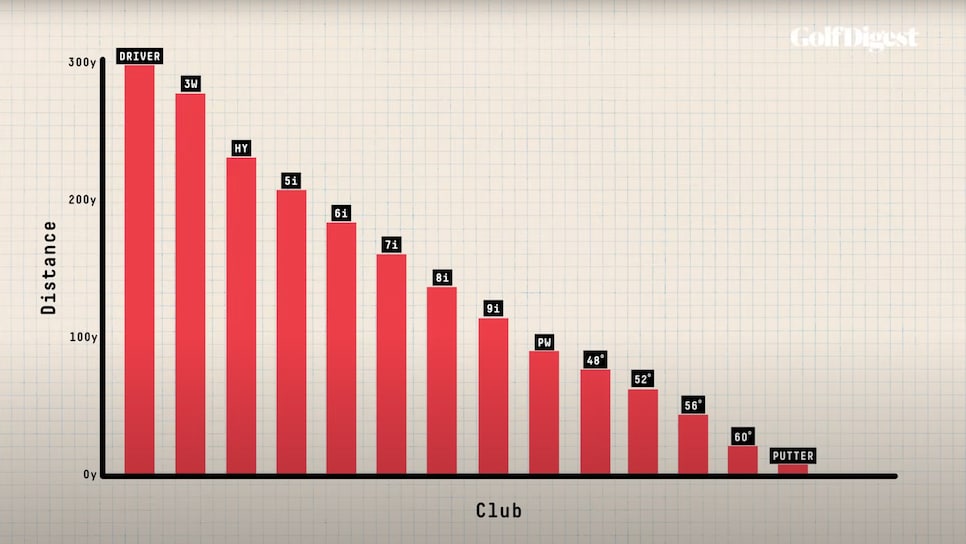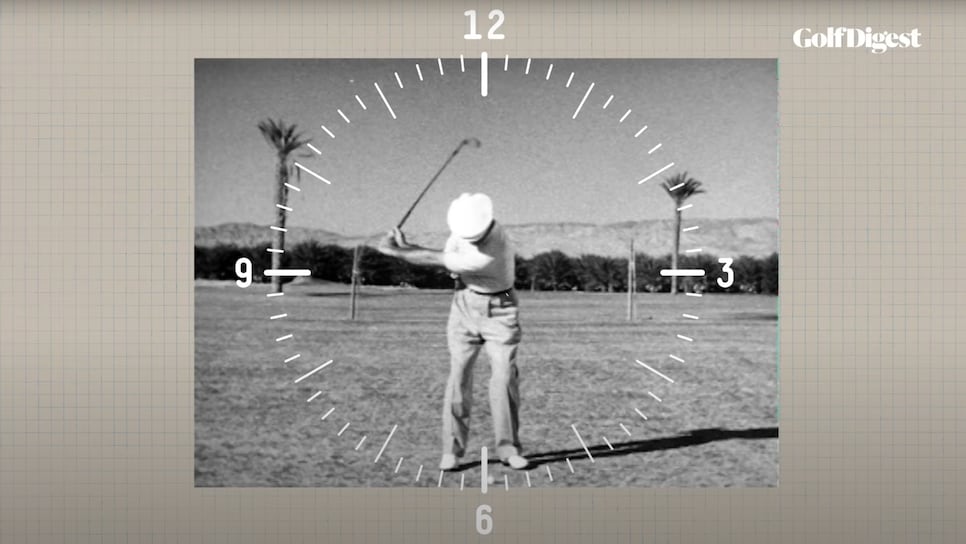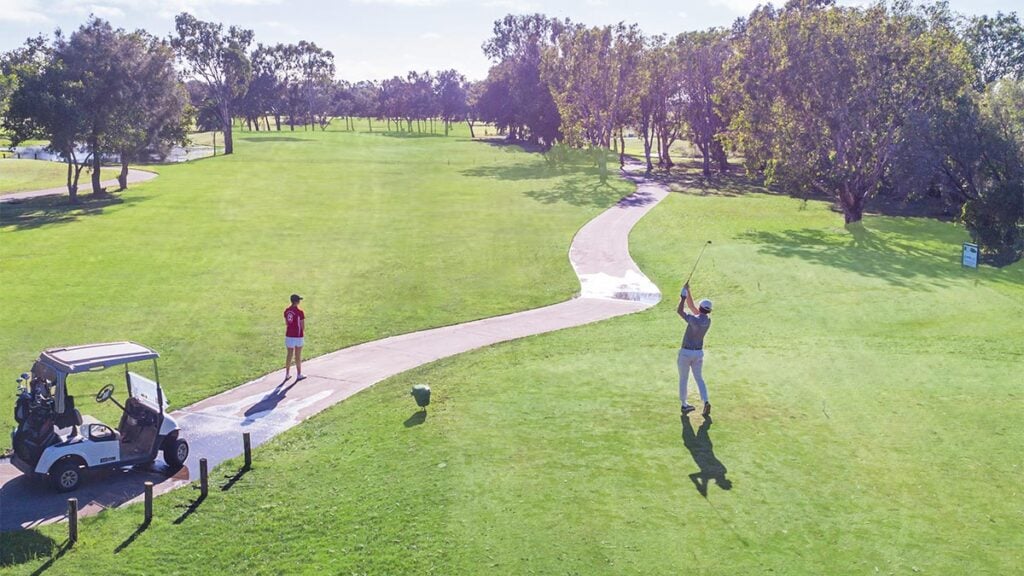The awkward 50 to 100 yard wedge shot is one of the most important areas in golf, for both pros and amateurs.
Pros don’t actually hit that many shots from here, but when they do, it’s high stakes stuff. The margins are thin and the stakes are high. Their performance here can be the difference between winning and losing a golf tournament or earning hundreds of thousands of dollars.
The rest of us kind of live in this zone. We hit way more shots than pros do from here, and for as much as we talk about distance off the tee, hitting our wedges better is an underrated way of getting a lot better.
Here’s how pros do it—and what golfers can learn from it.
The North-South Problem
The key problem to understand that’s harming your wedge shots is what golf statistician Lou Stagner terms the “north-south problem.”
When you look at amateur wedge stats from this scoring zone, it turns out that misses long or short of the intended target, “north or south”, are almost twice as big on average as left or right misses. So for a 5 handicap from 100 yards, that’s about seven yards left or right vs. 12 yards long or short. For tour pros it’s 4 yards vs 7 yards.

This transition from horizontal to vertical shot patterns as you get closer to the hole is really important to remember when you’re out on the course. The good news? Most of the time you’re probably not going to go too sideways with a wedge. The bad news? You’re more likely to end up way long or way short.
A perfect example came at the 2016 U.S. Open at Oakmont. Dustin Johnson, who went on to win, had four almost identical wedge shots on his first five holes of his final round. Each shot was right around 104 yards. The first two he left way short, right in line with the pin. The third he pumped long of the pin. These shots highlight one specific challenge in this scoring wedge zone that was statistically the weakest part of DJ’s game at the time.
Pros, on the whole, are really good at managing this north-south problem. But us amateurs aren’t that good at it at all. Pros get good at it by using three simple strategies that we can all emulate.
Strategy 1: Get your gapping right
The first is their club gapping strategy. As more and more really smart people started looking into this they started realizing what a bad idea evenly spaced clubs were. Our bags, it turns out, should not be evenly gapped.
PING data shows that golfers hit a huge amount of shots right around the 130 yard mark, and a lot either side of that. Dave Pelz in his short game bible measured this too and found the same thing. Golfers leave these big yardage gaps at the bottom of their bag where precision really matters, because they don’t have enough clubs in that section.
Simply put, you get more value from having more clubs and tighter yardage gaps at the bottom of your bag between your short irons or wedges than at the top of your bag. You just don’t need to be that precise from 200 to 220 yards. That 20 yard gap between clubs just isn’t as important as the one between 60 and 120 yards, where you kinda do need to be pretty precise.

This is why back in the 80s and 90s lots of pros used to just carry two wedges in their bag but now it’s not uncommon to see pros carrying five wedges. For amateurs, taking out one of their fairway woods and adding another wedge or short iron, is probably a smart trade.
Strategy 2: Hit your wedges low
Pros avoid really bad shots by using a really simple technique from this scoring wedge zone. They play the ball back in their stance, and make an aggressive, steeper swing into the ball. This combination creates a more consistent strike, and allows pros to bring the flight of the ball down while keeping the spin up. It’s just more reliable and safer to use.
A metric pros often use to measure this is a 50 percent rule, meaning they want to launch the ball at an angle that is 50 percent of the loft of the club they’re using. If you’re hitting a 60 degree wedge into a green, you generally wanna launch that shot at 30 degree. The ball is going to cut through the elements in the air, but have enough spin that it’ll grab when it lands without it spinning like crazy.
For context, the average driver apex on tour is about 100 ft, but when pros hit wedges, they lower that apex down to 80 ft, despite the loft of the club being way higher. And usually they go way lower. This is also why players with a lot of speed who naturally hit the ball high, players like DJ or Bryson or Rory, often struggle with scoring wedges, because they can’t keep the ball low enough.

When the time comes to change the distance the shot needs to go, pros change their backswing length rather than swinging harder or softer. The distance your hands travel on the backswing is a way better predictor of how long or short the ball is going to go than trying to swing harder or softer.
 Strategy 3: Picking A Lane
Strategy 3: Picking A Lane
Being good at wedges means more than simply avoiding hitting bad shots. You do have to hit good shots from here, because a good shot with a wedge puts you into a more makeable putt zone. Scottie Scheffler led the tour in proximity from 50-125 yards last season, with an almost 14 foot average proximity to the hole. Pros make, on average, about 33 percent of putts from 14 feet.

The most interesting little wrinkle is when pins are tucked deep to one side of the green. That’s when you see pros use a kind of side strategy that us amateurs just don’t do. If they went straight at these pins, the north and south misses would land in trouble, and they leave themselves no margin for error on the left and right even if they did block or pull one.
So in these situations, you’ll often see pros aim slightly to the right of left pins, or to the left of right pins, to a spot like 12 feet to the side. You can think of it almost like picking a safe lane to hit into. Now any north and south misses would be in a safer spot, and they still have a good look at birdie. Best case scenario, they catch a slope and end up super close.
These shots often look a little less glamorous, but they’re kind of a pros bread and butter from this range, and they often get overlooked by amateurs. Scoring from this range, it’s a subtle, simple art that has a lot of potential for our scores.
You can watch the full episode of Golf Digest’s The Game Plan, right here:
This article was originally published on golfdigest.com



